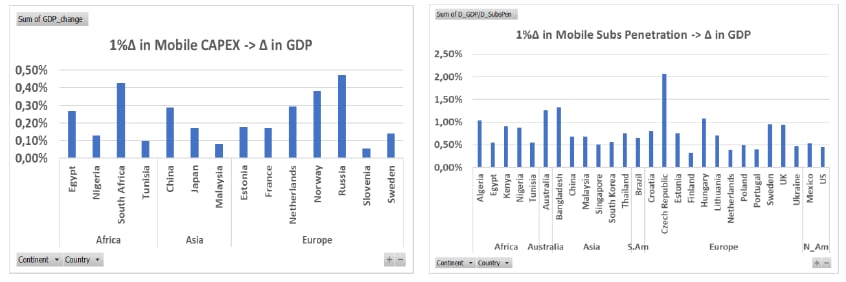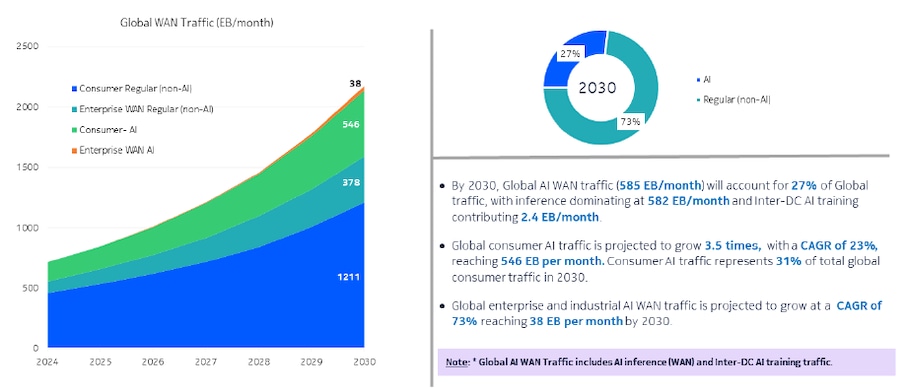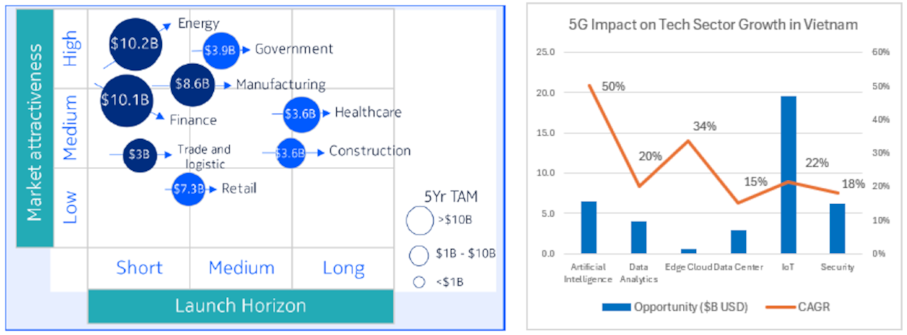Vietnam's Digital Transformation with 5G: A Key Driver for Economic Growth
With the introduction of 5G, Vietnam aspires to take a transformative leap into the future of digital connectivity and socio-economic upliftment. With ambitions to be a digital leader in Southeast Asia, the country is well-positioned to leverage 5G to boost innovation, transform key sectors, and drive socio-economic development.
This article explores Vietnam’s digital transformation through its 5G rollout, focusing on key areas driving socio-economic change. It examines how investments in mobile networks can boost GDP per capita, the role of AI in growing traffic demand, and the importance of effective spectrum allocation. The article also highlights 5G monetization strategies, identifying sectors like manufacturing, healthcare, and agriculture that will benefit the most, and emphasizes the need for continued regulatory support to ensure successful 5G implementation and long-term economic growth. The Ministry of Information and Communications (MIC) has played a critical role by issuing spectrum licenses, facilitating public-private partnerships, and setting clear policy frameworks to accelerate the national 5G rollout.
How does investment in mobile networks impact GDP per capita:
A recent analysis by Bell Labs Consulting examined the correlation between mobile network investments and GDP per capita for 43 countries. The study found a strong positive relationship, demonstrating that increased investments in mobile networks are linked to higher economic growth.
On average, a 1% increase in mobile network CAPEX was associated with a 0.25% increase in GDP per capita. Additionally, a 1% increase in mobile subscriber penetration led to a 0.6% increase in GDP per capita. These findings highlight the significant economic impact of mobile networks and their role in driving development of the country.
In Vietnam, historical data illustrates the powerful effect of mobile penetration on GDP per capita. As subscriber penetration rose from 20% to 80%, GDP per capita increased by approximately $1500. This demonstrates the potential for mobile networks to catalyze economic growth and improve living standards in developing countries.
Impact of AI on global traffic and role of 5G networks
The proliferation of AI applications across consumer and enterprise sectors, fueled by the rise of generative AI, is driving a surge in data traffic with unique demands for dynamic behavior, low latency, and high reliability. Bell Labs predicts that AI applications will contribute significantly to global WAN traffic by 2030, with consumer AI applications accounting for 25% and mobile AI applications contributing 36%. This growth is fueled by the increasing adoption of AI-powered services like chatbots, augmented reality, gaming, and personalized recommendations.
As illustrated in the accompanying chart, global AI WAN traffic is projected to grow at a compound annual growth rate (CAGR) of 73%, reaching 585 exabytes per month by 2030. This growth will be driven primarily by AI inference applications, which are expected to account for 582 exabytes per month by 2030. Consumer AI traffic is also projected to experience significant growth, reaching 546 exabytes per month by 2030, representing 31% of total global consumer traffic.
5G networks play a crucial role in supporting and driving the adoption of AI applications. Their high-speed, low-latency capabilities provide the bandwidth and performance necessary to handle data-intensive AI workloads. The massive increase in connected devices and mobile access capacity enabled by 5G networks creates an ideal environment for mobile AI applications to thrive. Additionally, 5G's network slicing feature allows operators to tailor network resources to the specific needs of AI applications, further enhancing their performance and user experience.
As Vietnam continues to invest in 5G infrastructure, it can proactively keep future demand in mind and take the right steps to position itself as a leader in AI and digital innovation and attract new businesses, create jobs, and improve the quality of life for its citizens.
5G Spectrum Allocation in Vietnam: A Balancing Act
The recent acquisition of new 5G spectrum by Vietnamese telecom operators presents both opportunities and challenges. As operators plan their 5G deployments, they must carefully weigh the trade-offs between wider coverage, higher capacity, and ecosystem support. The successful repurposing of existing bands and the allocation of new spectrum will be crucial for enabling the widespread adoption of 5G services in Vietnam and driving economic growth.
All three major Vietnamese telecom providers (Viettel, VNPT, and Mobiphone) have acquired significant 5G spectrum, including 100MHz in the 2.5-2.6GHz and 3.8-3.9GHz bands. This expansion provides each operator with 9x the capacity of their existing LTE networks when deployed with mMIMO. While lower frequencies offer wider coverage, most operators will benefit from stronger ecosystem support due to compatible devices.
Future spectrum allocation in Vietnam is challenging due to the use of 3.4-3.6GHz for satellite and radar services. Although allocation in the 3.6-3.7GHz band is possible, it may face interference issues with neighboring countries satellite services. Spectrum above 4GHz is primarily reserved for satellite services and has limited ecosystem support.
The Ministry of Information and Communications (MIC) has actively encouraged operators to phase out 2G GSM networks in the 900MHz and 1800MHz bands by September 2024. These bands could be repurposed for 5G coverage or auctioned for 700MHz spectrum. During initial non-standalone (NSA) 5G deployments, LTE bands, especially 1800MHz, will serve as the anchor layer. To enable wide-area standalone 5G coverage, a lower frequency band will be necessary.
5G Monetization Strategies for Vietnam: Which Sectors Will Benefit the Most?
Vietnam's tech industry is on the brink of a major leap forward, with 5G set to play a pivotal role in the country's growth. Projections suggest that by 2028, the tech industry could generate up to $25 billion in revenue from 5G alone, accounting for about 20% of the estimated total tech revenue of $125 billion during this period. This substantial contribution underscores 5G's transformative impact on key sectors like manufacturing, energy and finance.
In manufacturing, 5G-enabled smart factories could lead to a 25% increase in productivity by enabling real-time monitoring and improved quality control, reducing downtime and boosting output. The energy sector too stands to benefit immensely, with 5G facilitating grid optimization and the integration of renewable energy sources, leading to a more reliable and sustainable power supply. Financial automation driven by 5G is expected to streamline operations, opening up new revenue streams and enhancing the sector's overall efficiency.
Beyond these economic benefits, 5G is poised to improve public safety and quality of life in Vietnam. For example, 5G-enabled advanced surveillance systems and emergency response solutions could cut response times by up to 50%, leading to quicker and more effective incident management. In healthcare, 5G's capabilities in telemedicine and remote patient monitoring could improve access to care, especially in rural areas, ensuring better health outcomes for more people.
The potential of 5G doesn't stop there. When combined with artificial intelligence (AI), which is expected to grow into a $6 billion market in Vietnam by 2028 with a CAGR of 50%, the possibilities expand even further. Together, 5G and AI can drive innovation in fields like autonomous vehicles, healthcare diagnostics and personalized retail experiences. Distributed edge deployments, supported by 5G, will enable real-time data processing, creating a more responsive and intelligent digital infrastructure.
This powerful combination of 5G and AI will not only contribute to Vietnam's economic growth but also position the country as a leader in digital innovation. By embracing these technologies, Vietnam can create new jobs, drive productivity across various industries and significantly improve the overall well-being and quality of life for its citizens.
Regulatory and Policy Framework: Paving the Way for 5G in Vietnam
MIC's proactive approach to spectrum allocation, pilot programs, regulatory reforms, international partnerships, and public engagement has been instrumental in creating a favourable environment for 5G development in Vietnam. These efforts have laid the groundwork for the successful rollout of 5G services and the realization of its potential benefits. Bell Labs Consulting recommends developing a comprehensive cybersecurity framework to protect Vietnam's critical 5G infrastructure and provide telecom operators with actionable guidelines for implementing effective security controls.
To sustain growth, Government must continue its support through clear regulations around spectrum use, data privacy, and cybersecurity. Additionally, policies that promote public-private partnerships will be essential for financing large-scale 5G infrastructure projects. Collaboration between the government, telecom operators, and tech companies is critical for addressing challenges such as high deployment costs, ensuring fair competition, and maintaining network security in the 5G era.
This will lay a strong foundation for Vietnam to capitalize on the transformative potential of 5G technology.
Nokia Bell Labs is the leading research arm of Nokia and has been shaping society with technical innovations for about 100 years. Bell Labs has been inventing the future of technology, from the early days of the Bell Telephone System to the future 6G landscape. We constantly improve, innovate and propel communication forward, solving the challenges of human needs before they exist. Bell Labs Consulting is the consulting part of Nokia Bell Labs and provides impartial advice to help clients realize the full economic, social, and human potential of future technologies.
Bell Labs Consulting provides impartial advice to help clients realize the full economic, social, and human potential of future technologies.


